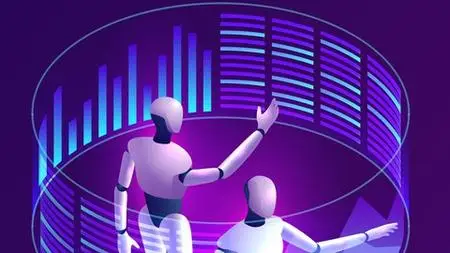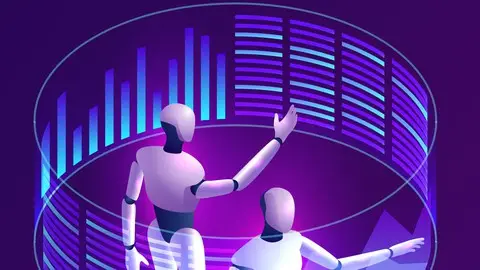Natural Language Processing | Nlp Web App | Rnn & Lstm
Last updated 2/2023
MP4 | Video: h264, 1280x720 | Audio: AAC, 44.1 KHz
Language: English | Size: 1.01 GB | Duration: 3h 35m
Last updated 2/2023
MP4 | Video: h264, 1280x720 | Audio: AAC, 44.1 KHz
Language: English | Size: 1.01 GB | Duration: 3h 35m
Create Word Cloud App Using Streamlit | Sentiment Analysis | Speech to text | Spam Detection | Code Walkthrough
What you'll learn
You will gain insights on what Natural Language Processing(NLP) is, its Applications & Challenges
You will learn Sentence Segmentation, Word Tokenization, Stemming, Lemmatization, Parsing, POS & Ambiguities in NLP
You will learn to execute using Machine Learning, NLTK & Spacey
You will learn to work with Text Files with Python
You will utilize Regular Expressions for pattern searching in text
You will use Part of Speech Tagging to automatically process raw text files
You will visualize POS and NER with Spacy
You will understand Vocabulary Matching with Spacy
You will use NLTK for Sentiment Analysis
Requirements
None. (Python is covered extensively in the course)
Description
Natural Language Processing (NLP) is a very interesting field associated with AI and is at the forefront of many useful applications like a chatbot. Knowledge of NLP is considered a necessity for those pursuing a career in AI. This course covers both the theory as well as the applications of NLP. Case studies are explained along with a walkthrough of the codes for a better understanding of the subject.A detailed explanation of how to build a web app for NLP using Streamlit is also explained.NLP is a subfield of computer science and artificial intelligence concerned with interactions between computers and human (natural) languages. It is used to apply machine learning algorithms to text and speech.For example, we can use NLP to create systems like speech recognition, document summarization, machine translation, spam detection, named entity recognition, question answering, autocomplete, predictive typing and so on.Nowadays, most of us have smartphones that have speech recognition. These smartphones use NLP to understand what is said. Also, many people use laptops whose operating system has built-in speech recognition.Some Examples:1.CortanaThe Microsoft OS has a virtual assistant called Cortana that can recognize a natural voice. You can use it to set up reminders, open apps, send emails, play games, track flights and packages, check the weather and so on.2.SiriSiri is a virtual assistant of the Apple Inc.’s iOS, watchOS, macOS, HomePod, and tvOS operating systems. Again, you can do a lot of things with voice commands: start a call, text someone, send an email, set a timer, take a picture, open an app, set an alarm, use navigation and so on.In this course we will deal with:a)NLP Introduction:· What is NLP· Applications of NLP· Challenges in NLPb)Key concepts in NLP:· Sentence Segmentation· Word Tokenization· Stemming· Lemmatization· Parsing· POS· Ambiguities in NLPc)NLP in Action· NLTK· Sentence Tokenization· Word Tokenization· Stemming· Lemmatization· Noise Removal· Spacy· Parts of Speech Tagging· Dependency Parsing· Spell Correction· Point of View· Regular Expressions· Flash Text· Named Entity Recognition - NERd)Case studies:· Speech recognition· Sentiment analysis· Word Cloud· Spam detectionYou will not only get fantastic technical content with this course, but you will also get access to both our course-related Question and Answer forums, as well as our live student chat channel, so you can team up with other students for projects, or get help on the course content from myself and the course teaching assistants.All of this comes with a 30-day money back guarantee, so you can try the course risk-free.What are you waiting for? Become an expert in natural language processing today!
Overview
Section 1: Introduction
Lecture 1 Introduction
Section 2: Key concepts in NLP
Lecture 2 Key concepts in NLP: Sentence Segmentation
Lecture 3 Key concepts in NLP: Word Tokenization
Lecture 4 Key concepts in NLP: Stemming
Lecture 5 Key concepts in NLP: Lemmatization
Lecture 6 Key concepts in NLP: Stop Words
Lecture 7 Key concepts in NLP: Dependency Parsing
Lecture 8 Key concepts in NLP: Parts of Speech
Section 3: Ambiguities in NLP
Lecture 9 Ambiguities in NLP
Section 4: NLP Libraries and Coding for NLP
Lecture 10 NLTK and NLP in action
Lecture 11 Noise removal
Lecture 12 Spacy
Lecture 13 Flash Text
Lecture 14 Named Entity Recognition (NER)
Section 5: Case Studies (with walk through of the codes)
Lecture 15 Case Study 1: Sentiment Analysis & Word Cloud
Lecture 16 Case Study 2: Speech to Text deployment in a call center
Lecture 17 Case Study 3: Text Summarization
Lecture 18 Case Study 4: Spam Classification Using Machine Learning
Section 6: Creating an NLP Web App Using Streamlit
Lecture 19 Infrastructure for Streamlit
Lecture 20 Creating a very simple web app and Getting started with streamlit
Lecture 21 Header and Sub Header
Lecture 22 Reading and displaying contents of a file
Lecture 23 Uploading a file
Lecture 24 NLP Wordcloud App
Lecture 25 Deploying the app in Heroku
Lecture 26 Deploying the app in streamlit
Section 7: Deep Learning in NLP
Lecture 27 Why do you need RNN
Lecture 28 Math Behind RNN
Lecture 29 LSTM
Lecture 30 Build a Spam Detection Model Using RNN and LSTM
Section 8: Python Programming Using Google Colab
Lecture 31 Introduction to Colab: Google Cloud Development Environment
Section 9: Machine Learning Concepts
Lecture 32 Machine Learning Concepts
Lecture 33 Logistic Regression and Introduction to Deep Learning
Section 10: Bonus Lecture
Lecture 34 Bonus Lecture
Data Scientists, Python Programmers, ML Practitioners, IT Managers managing data science projects,Python developers interested in learning how to use Natural Language Processing



